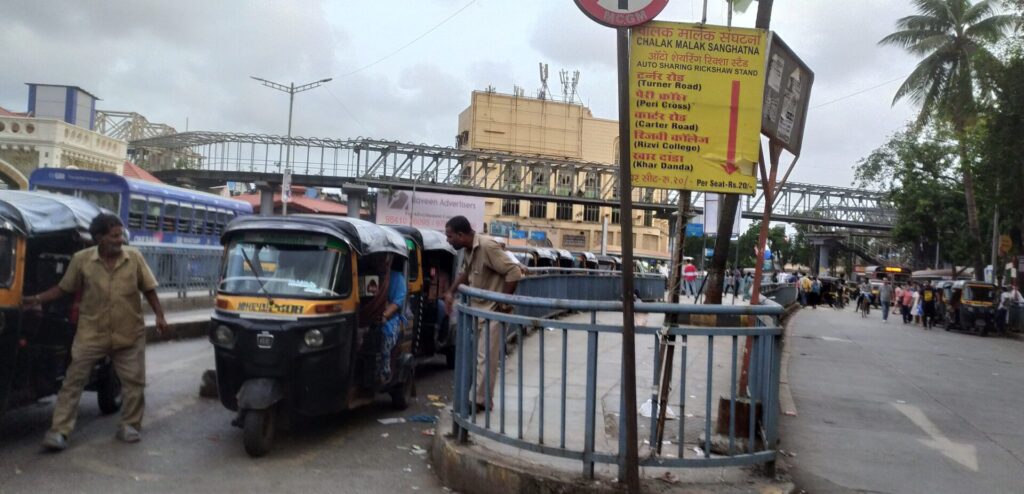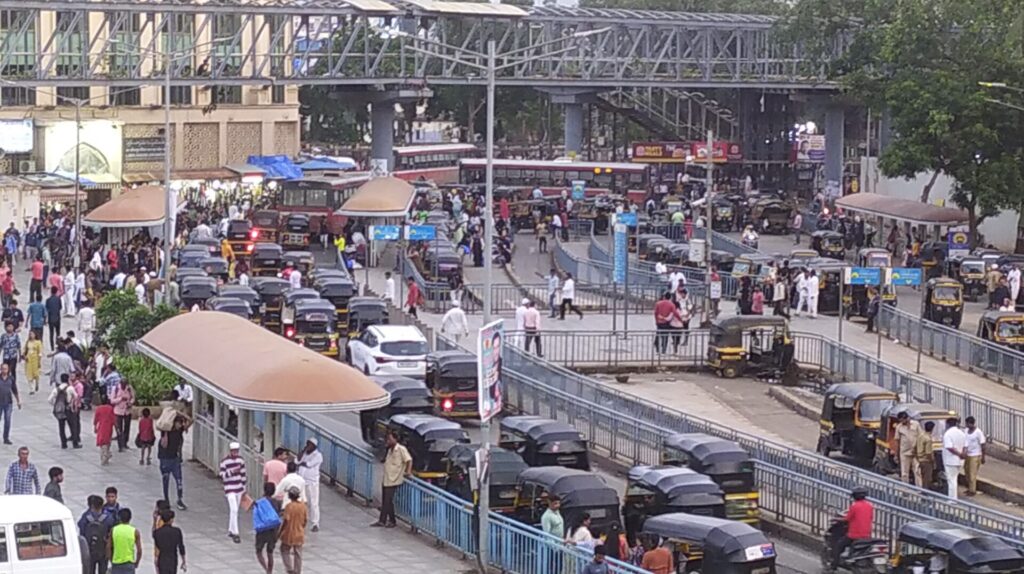The system of sharing autorickshaw rides with unknown fellow passengers travelling on the same route, may seem a win-win solution for citizens, as they’re convenient, quick and pocket-friendly; and also for auto drivers as they get good money. But it does not always work so smoothly.
Many shared auto stands are run illegally, especially near suburban railway stations. The auto drivers overcharge the commuters and as many as four to five passengers, when only three are allowed. With metered autorickshaws refusing to ply on those routes, commuters do not have much choice.
An estimated 2.5 lakh autorickshaws ply in suburban Mumbai. And yet scores of illegal shared auto stands have mushroomed at many important points for longer commute, to meet the demands of the burgeoning population in the suburbs.
In a survey, the Mumbai Rickshawmen’s Union found about 86 illegal shared auto stands operating only in the western suburbs.
However, there is no denying the utility of shared autos. Apart from being cost effective, they are climate-friendly and help is reducing emissions, carbon footprint and can curb traffic congestion. The need to make them efficient and regulated for last mile connectivity in Mumbai is expressed by most commuters.
What is the difference between a legal and illegal shared auto stand?
Those who run the illegal shared auto stands decide the fares, chart their own routes and even decide their disembarking points.
Very often they don’t follow traffic rules creating chaos near entry-exit points of railway stations. When a large number of auto rickshaws park themselves at strategic entry-exit points near railway stations, they tend to block access, cause jams and often become a nuisance for passengers.
Why are so many illegal stands proliferating in the city?
Shashank Rao, president of the Mumbai auto rickshaw taximen’s union blames long bureaucratic procedural delays for mushrooming of illegal auto stands. “Getting approval for official shared auto stands involves a joint inspection by traffic officials above the rank of assistant commissioner along with officials of the Brihanmumbai Municipal Corporation BMC and Road Transport Office (RTO). This coordination takes time. Inspections and approvals for stands should be done as a routine. Approvals should be granted in a time-bound manner to meet the huge demand for shared auto stands,” says Rao. Currently, the Mumbai Metropolitan Regional Transport Authority (MMRTA) meets only a few times in the year.

What do passengers say about illegal shared autos?
While the model is effective, the reality on the ground is different. Many auto drivers ply extra passengers than permitted, force passengers to squeeze in uncomfortably, to make more money. They also overcharge in situations like heavy traffic or incessant rains.
Commuters like Amit Gupta complain that the sanctioned fare and the standard charged fare are not displayed properly. “At commercial districts like the BKC, the auto drivers randomly hike rates during the morning and evening peak hours. One is forced to concede because metered autorickshaws refuse to ply on that route. I normally shell out Rs 30 for travelling between Bandra station (E) to BKC in a share auto, with two other passengers. A metered auto would cost just Rs 46 for the same distance, says Amit. The shared auto driver actually makes twice the amount – Rs 90 – for the same distance.
At Kandivali station (East), he is often asked to sit next to the driver. “When one refuses to do that, they simply ask you to get down. Auto drivers also expect you to adjust with four passengers behind while paying full fare,” he says.
Though the BEST buses are available on the same route, he is unable to use them because they are “crowded, unreliable and have very bad frequency during peak hours”.
Read more: Traffic woes around Thane station road a never-ending problem
How can you find out the actual fare on your route?
If the shared auto stand is legal, the per passenger fare is mentioned on the board along with the route. If not, then you can check from the local RTO offices at Wadala, Andheri or Dahisar for the approved fares on particular routes.
How are the fares calculated?
The per passenger fares for a shared auto are determined by a committee composed of the principal secretary (transport), transport commissioner and joint commissioner (traffic) along with the divisional RTO officials.
The fare is calculated on a set formula determined by the Khatau committee, which was formed in 2016 to come up with a revised fare policy for taxis and auto rickshaws operating in Maharashtra.
“The shared auto fare is calculated by adding the standard meter fare for the route with 33% of the meter fare. This sum is divided by three to arrive at the per passenger fare. The extra 33% of fare is granted to compensate for the return journeys that auto drivers would make without a passenger, since shared autos generally tend to have only one-way heavy passenger traffic,” explains Rao.
How can you start a shared auto stand in your locality?
“One can make an application for a share auto stand at a particular point or route on the official letterhead of the housing society or as an individual to the local RTO office or with the local traffic police or even the local autorickshaw union. A no-objection certificate (NOC) is required from the BMC / building/ private developer, who owns the land,” explains a senior RTO official. Thereafter, NOC’s are needed from the local traffic police to assess to ensure that it will not affect traffic. The local police check for law and order issues.
“Once all the departmental clearances are obtained, then a request is put up before the Mumbai Metropolitan Regional Transport Authority (MMRTA) for their nod. Once the MOM is signed and uploaded on their website, the shared auto stand is declared official. Thereafter, the BMC erects a stand at the particular location with details of the route and fare,” explains Thampi Kurien, the general secretary of the Mumbai Rickshawmen’s Association.

Why are errant drivers not penalised most of the times?
There is a huge gap in action against errant auto drivers. Officials attribute it to the shortage of staff with the Road Transport Organisation (RTO). “The RTO is also involved in managing many other responsibilities like handling documentation of vehicles including registrations, issuing driving licenses, checking fitness of vehicles, following accident protocols and documentation. Action against illegal auto stands tends to lag behind in such circumstances. Since we are short on staff, the local police have been authorised to levy fines and act against illegal stands,” explains a senior RTO official.
How can the situation improve?
Amit suggests that all shared auto display boards should also have phone numbers to register complaints so that it is easier to lodge complaints. Also, traffic officials should be around to reassure passengers and to address the issue. “Often, clicking pics of autorickshaws can get risky as the auto drivers could get aggressive or use abusive language,” he says.
Undoubtedly, the shared auto system is popular and here to stay but constant vigilance by officials and citizens alike is needed to ensure better last mile connectivity.
What action does the RTO take?
Auto drivers can be penalised Rs 2000 for refusal to ply and Rs 3000 for demanding excess fares under provisions of the Motor Vehicle Act,1988.
However, there is a huge gap between complaints and action taken. Moreover, there is no option for immediate relief as traffic personnel are not present near these shared auto stands to intervene and act against errant auto drivers.
What are the legal options for citizens?
Citizens can complain on the various numbers on WhatsApp. One needs to remember that the Regional Transport Office (RTO) in Mumbai, which oversees traffic regulations is divided into four different zones and there are different numbers to complain against autorickshaws registered in different zones.
For example, the complaints for autorickshaws with numbers beginning with MH-02 are to be sent on 9920240202 or mh02autotaxicomplaint@gmail.com, while WA complaints have to be sent on 85919 44747 or mh47autotaxicomplaint@gmail.com for autorickshaw numbers beginning with MH-47. Similarly, complaints against autorickshaws with MH-03 numbers can be sent on 9152240303 or mh03autotaxicomplaint@gmail.com.
The complaint should include details like vehicle number, location and time along with a picture of the autorickshaw.